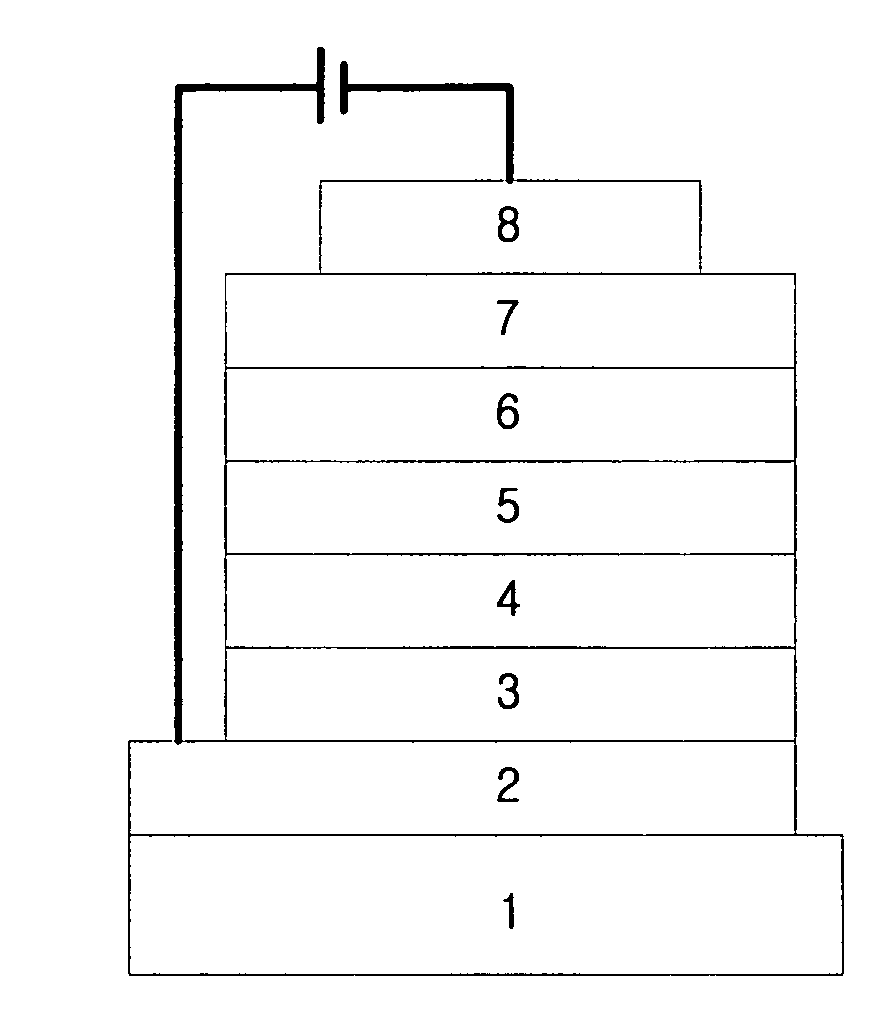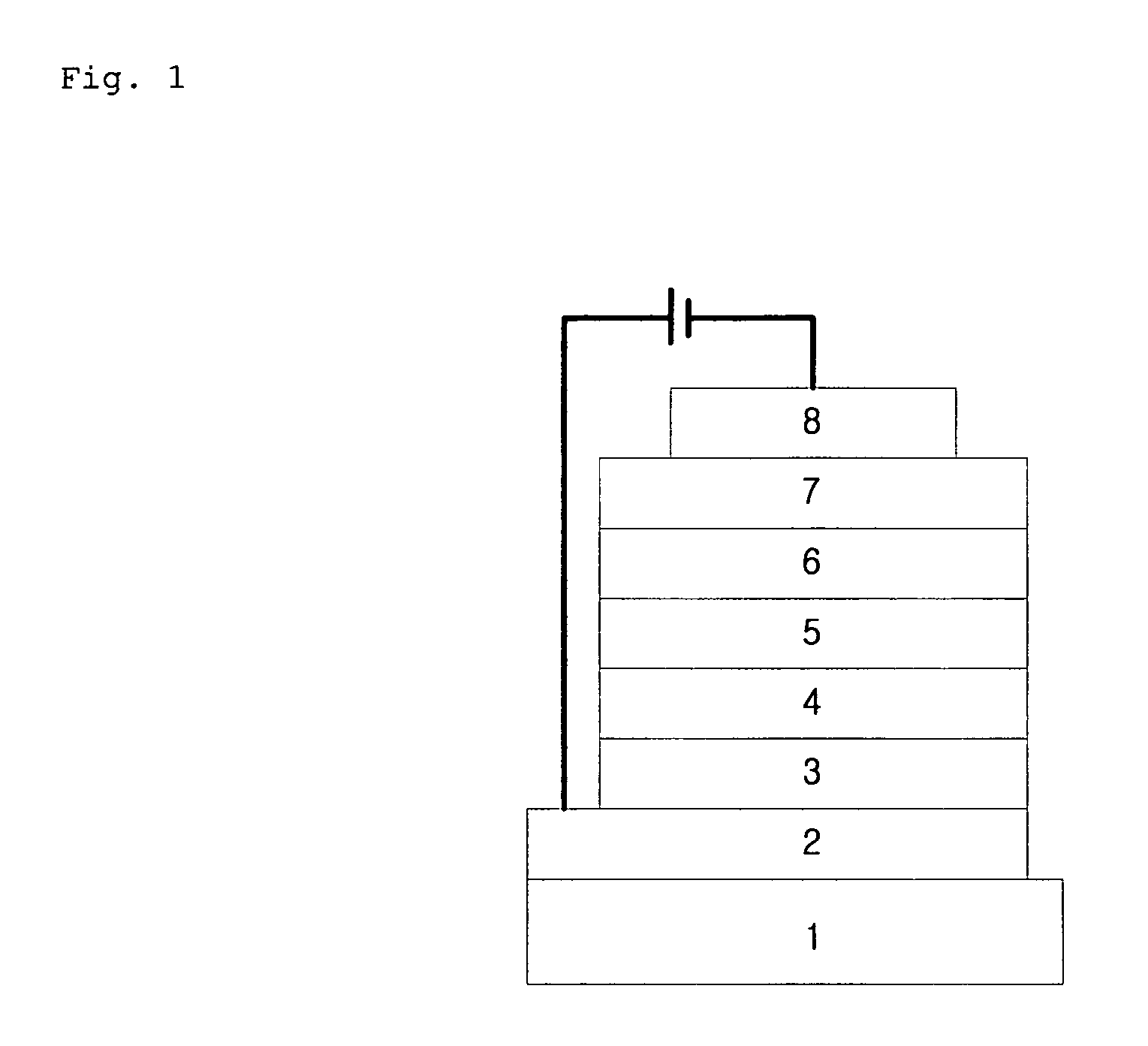Novel organic electroluminescent compounds and organic electroluminescent device using the same
a technology of organic electroluminescent compounds and organic electroluminescent devices, which is applied in the directions of organic chemistry, transportation and packaging, web handling, etc., can solve the problems of insufficient life and poor luminous efficiency, and achieve excellent luminous efficiency and improve life properties
- Summary
- Abstract
- Description
- Claims
- Application Information
AI Technical Summary
Benefits of technology
Problems solved by technology
Method used
Image
Examples
preparation examples
Preparation Example 1
Preparation of Compound (1)
[0120]
[0121]Preparation of Compound (A)
[0122]Under nitrogen atmosphere, 2,6-bis(bromomethyl)naphthalene (5 g, 15.9 mmol) was dissolved in dioxane (150 mL), and 1-pyrrolidino-1-cyclohexene (5.3 g, 35 mmol) was added thereto, and the mixture was heated under reflux for 18 hours. After adding water (200 mL), the resultant mixture was heated for 2 hours. The solvent was evaporated off, and the residue was worked-up by using ether, 5% HCl and 5% NaHCO3 solution. After evaporation, the residue was purified via column chromatography by using benzene and hexane (1:1) to obtain Compound (A) (4.3 g, 78%).
[0123]Preparation of Compound (B)
[0124]Compound (A) (4.3 g, 12.3 mmol) was dissolved in a mixture (70 mL) of CHCl3 and 10% methanesulfonic acid, and the solution was stirred at ambient temperature for 2 hours. After quenching the reaction by adding bicarbonate solution, the mixture was worked-up with NaHCO3 and water. The solvent was evaporated,...
preparation example 2
Preparation of Compound (19)
[0131]
[0132]Preparation of Compound (19)
[0133]In a reaction vessel, Compound (D) (7 g, 11.89 mmol), diphenylamine (6.1 g, 35.69 mmol), Pd(OAc)2 (0.13 g, 0.59 mmol), tri(tert-butyl)phosphine (50% in toluene) (0.58 mL, 1.18 mmol), sodium tert-butoxide (4.57 g, 47.56 mmol) and DMF (100 mL) were stirred at 140° C. for 12 hours. The mixture was then cooled to ambient temperature, and distilled water (100 mL) was added thereto. The solid produced was filtered under reduced pressure, and purified via column chromatography (ethyl acetate:hexane=2:1) to obtain the target compound (Compound 19) (3.7 g, 40.47%).
[0134]The organic electroluminescent compounds (Compounds 1 to 1176) were prepared according to the same procedure as in Preparation Example 1 and 2, and the 1H NMR and MS / FAB data of the compounds prepared are listed in Table 1.
TABLE 1MS / FABCompound1H NMR (CDCl3, 200 MHz)foundcalculated1δ = 1.78 (12H, s), 7.13 (2H, m), 7.41 (2H, m),512.68512.257.51~7.52 (8H,...
example 1
Electroluminescent Properties of OLED Employing the Organic Electroluminescent Compound of the Invention (I)
[0135]An OLED device was manufactured by using an electroluminescent material according to the invention.
[0136]First, a transparent electrode ITO thin film (15Ω / □) (2) prepared from glass for OLED (1) (manufactured by Samsung-Corning) was subjected to ultrasonic washing with trichloroethylene, acetone, ethanol and distilled water, sequentially, and stored in isopropanol before use.
[0137]Then, an ITO substrate was equipped in a substrate folder of a vacuum vapor-deposit device, and 4,4′,4″-tris(N,N-(2-naphthyl)-phenylamino)triphenylamine (2-TNATA) (of which the structure is shown below) was placed in a cell of the vacuum vapor-deposit device, which was then ventilated up to 10−6 torr of vacuum in the chamber. Electric current was applied to the cell to evaporate 2-TNATA, thereby providing vapor-deposit of a hole injecting layer (3) having 60 nm thickness on the ITO substrate.
[0...
PUM
| Property | Measurement | Unit |
|---|---|---|
| Length | aaaaa | aaaaa |
| Length | aaaaa | aaaaa |
| Length | aaaaa | aaaaa |
Abstract
Description
Claims
Application Information
 Login to View More
Login to View More - R&D
- Intellectual Property
- Life Sciences
- Materials
- Tech Scout
- Unparalleled Data Quality
- Higher Quality Content
- 60% Fewer Hallucinations
Browse by: Latest US Patents, China's latest patents, Technical Efficacy Thesaurus, Application Domain, Technology Topic, Popular Technical Reports.
© 2025 PatSnap. All rights reserved.Legal|Privacy policy|Modern Slavery Act Transparency Statement|Sitemap|About US| Contact US: help@patsnap.com



